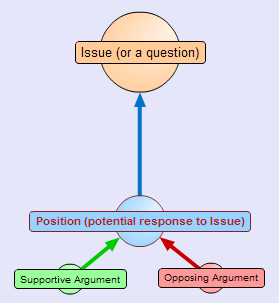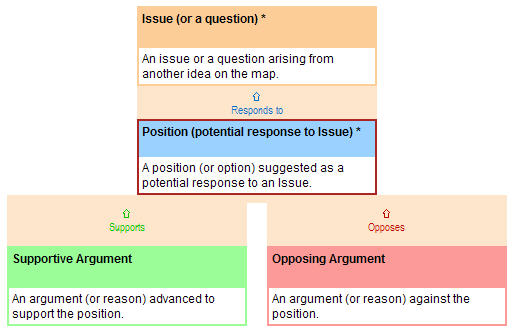Here is how it works:
- the students will create a main "bubble" that is their topic (issue)
- they can then (each on a different side of the issue) add bubbles off of the main one with their stance, response, ideas, etc. (much like a web diagram) -- these branches will continue to grow and expand as the students add more details/arguments to support their stance and/or argue their opponent's ideas.
Example of a debate in progress: http://debategraph.org/Stream.aspx?nid=3664&iv=05 (if you click on the bubbles, they change and expand to show more of the debate for each sub-topic/idea)
Here is a breakdown from Debategraph's website:
The basic building blocks of the mapsIn essence, building the maps involves three steps:
- breaking down the subject into meaningful ideas;
- figuring out the relationships between those ideas; and,
- expressing the ideas and relationships visually.

(Explorer and Hub views)

(Zoom view)
There's a wider set of building blocks beyond the three core ones, but the core set of Issues, Positions, and Supportive andOpposing Arguments can be combined and recombined many times to build rich maps on any scale.
One of the main things I like about using debategraph is that, as opposed to a traditional debate, this allows students to organize and write out their ideas and viewpoints in an organized, less confrontational manner. Also, others can add their ideas and support to the debate, making it more interactive and collaborative while remaining very organized.
This program could be used as the debate itself or as a brainstorming and organization tool before a traditional debate.
I like this! I used to teach debate and can see how this would be a fun, handy tool, especially for students who aren't really "into" debate.
ReplyDeleteI think that this sounds like a great tool. I agree that it creates a less confrontational atmosphere. This is also a great way for the students who don't like to get up in front of the class to state an opinion a way to participate without being out there in front of the class.
ReplyDeleteyes! I am the kind of person who likes to think and form complete thoughts before I make a statement, something which you often do not have time to do in traditional debates! This could be a way for those types of students to feel more comfortable debating with others as they can have time and space to lay out their thoughts and ideas.
DeleteOh gosh, I didn't like debate class at all, but could really see this being useful in the classroom! It does really help with organization and writing as well! I'm trying to think of a way to use this in the elementary classroom and have kids debate topics, like whether or not they think the groundhog would see it's shadow or a type of question that requires some thoughtful insight as to why they believe that or not.
ReplyDelete